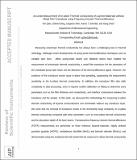| dc.contributor.author | Qian, Xin | |
| dc.contributor.author | Ding, Zhiwei | |
| dc.contributor.author | Shin, Jungwoo | |
| dc.contributor.author | Schmidt, Aaron | |
| dc.contributor.author | Chen, Gang | |
| dc.date.accessioned | 2020-06-12T13:44:46Z | |
| dc.date.available | 2020-06-12T13:44:46Z | |
| dc.date.issued | 2020-06 | |
| dc.date.submitted | 2020-02 | |
| dc.identifier.issn | 0034-6748 | |
| dc.identifier.issn | 1089-7623 | |
| dc.identifier.uri | https://hdl.handle.net/1721.1/125778 | |
| dc.description.abstract | Measuring anisotropic thermal conductivity has always been a challenging task in thermal metrology. Although recent developments of pump–probe thermoreflectance techniques such as variable spot sizes, offset pump–probe beams, and elliptical beams have enabled the measurement of anisotropic thermal conductivity, a metal film transducer enabled for the absorption of the modulated pump laser beam and the detection of the thermoreflectance signal. However, the existence of the transducer would cause in-plane heat spreading, suppressing the measurement sensitivity to the in-plane thermal conductivity. In addition, the transducer film also adds complexity to data processing, since it requires careful calibration or fitting to determine extra parameters such as the film thickness and conductivity, and interface conductance between the transducer and the sample. In this work, we discussed the methodology for measuring in-plane thermal conductivity of layered semiconductors and semimetals without any transducer layer. We show that the removal of transducer results in the dominantly large sensitivity to in-plane thermal conductivity compared with other parameters, such as cross-plane thermal conductivity and the absorption depth of the laser beams. Transducerless frequency-domain thermoreflectance (FDTR) measurements are performed on three reference layered-materials, highly ordered pyrolytic graphite, molybdenum disulfide (MoS2), and bismuth selenide (Bi2Se3) and demonstrated using the analytical thermal model that the measured in-plane thermal conductivity showed much-improved accuracy compared with conventional FDTR measurement with a transducer. | en_US |
| dc.description.sponsorship | Office of Naval Research (Grant N00014-16-1-2436) | en_US |
| dc.description.sponsorship | National Science Foundation (Grant CBET-1851052) | en_US |
| dc.publisher | AIP Publishing | en_US |
| dc.relation.isversionof | http://dx.doi.org/10.1063/5.0003770 | en_US |
| dc.rights | Creative Commons Attribution-Noncommercial-Share Alike | en_US |
| dc.rights.uri | http://creativecommons.org/licenses/by-nc-sa/4.0/ | en_US |
| dc.source | Prof. Gang Chen | en_US |
| dc.title | Accurate measurement of in-plane thermal conductivity of layered materials without metal film transducer using frequency domain thermoreflectance | en_US |
| dc.type | Article | en_US |
| dc.identifier.citation | Qian, Xin et al. "Accurate measurement of in-plane thermal conductivity of layered materials without metal film transducer using frequency domain thermoreflectance." Review of Scientific Instruments 91, 6 (June 2020): 064903 | en_US |
| dc.contributor.department | Massachusetts Institute of Technology. Department of Mechanical Engineering | en_US |
| dc.relation.journal | Review of Scientific Instruments | en_US |
| dc.eprint.version | Author's final manuscript | en_US |
| dc.type.uri | http://purl.org/eprint/type/JournalArticle | en_US |
| eprint.status | http://purl.org/eprint/status/PeerReviewed | en_US |
| dspace.date.submission | 2020-06-02T15:08:13Z | |
| mit.journal.volume | 91 | en_US |
| mit.journal.issue | 6 | en_US |
| mit.license | OPEN_ACCESS_POLICY | |
| mit.metadata.status | Complete | |
